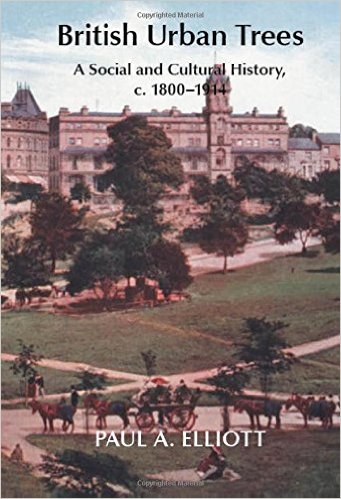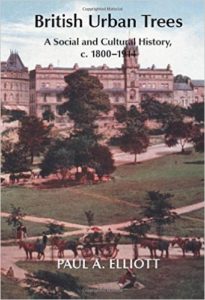
 This book is a very useful, heavily illustrated account of trees and tree-planting in British cities during the nineteenth century. It combines recent research on the history of gardening and arboriculture, as well as urban and environmental approaches. Though heavily concerned with Victorian parks and the creation of arboreta, as well as villa gardens, Paul Elliot has fascinating things to say on tree-lined streets, cemeteries, hospitals, and other green spaces. The analysis is more descriptive than quantitative, though there are flashes of data: thus 33,000 trees planted at Abbey Park, Leicester, a thousand varieties in the Nottingham and Derby arboreta, 9,000 trees and shrubs in the Glasgow Botanic Gardens. The book starts with a general survey of trees in private gardens, parks, and cemeteries, followed by detailed case studies of Victorian Nottingham, Glasgow, and Cardiff; the study concludes with chapters on trees and urban pollution, and the special arboriculture of spas and resort towns.
This book is a very useful, heavily illustrated account of trees and tree-planting in British cities during the nineteenth century. It combines recent research on the history of gardening and arboriculture, as well as urban and environmental approaches. Though heavily concerned with Victorian parks and the creation of arboreta, as well as villa gardens, Paul Elliot has fascinating things to say on tree-lined streets, cemeteries, hospitals, and other green spaces. The analysis is more descriptive than quantitative, though there are flashes of data: thus 33,000 trees planted at Abbey Park, Leicester, a thousand varieties in the Nottingham and Derby arboreta, 9,000 trees and shrubs in the Glasgow Botanic Gardens. The book starts with a general survey of trees in private gardens, parks, and cemeteries, followed by detailed case studies of Victorian Nottingham, Glasgow, and Cardiff; the study concludes with chapters on trees and urban pollution, and the special arboriculture of spas and resort towns.
Professor Elliott’s argument is persuasive: that trees were an essential part of the greening and emparking of British cities in the nineteenth century. Native trees, but also many imported species, and increasingly flowering bushes were planted in thousands, filling out new green spaces in bourgeois domestic gardens, civic parks, institutional gardens, streets, and so forth. Trends were similar across the country, though the exact chronology varied between cities, reflecting local factors: thus at Nottingham the Enclosure Act of 1845 opened the door to the foresting and greening of the city with the Arboretum established in 1852, along with numerous walks and parks; at Glasgow the main developments climaxed in the 1870s, 1880s and after, as the city struggled to overcome its stark economic and social divisions and promote its national and imperial image; while at Cardiff wooded parks and walks arrived towards the end of the century as the corporation sought to boost the city’s claim as the modern industrial capital of Wales. With mounting industrial and domestic household pollution taking their toll, blackening and poisoning trees, park departments adapted their plantings to take account, replacing vulnerable species like some evergreens with more resilient varieties such as the London plane, elms, ash, limes, Turkey or Austrian oaks and sycamores, along with flowering bushes like laburnums, lilacs, and rhododendrons.
Elliott makes clear the range of forces shaping the development of urban forestry in British cities. Middle-class concern to individualize and “privatize”their villa residences by surrounding them with trees and other forms of “nature,” played its part, linked to the new culture of the domesticated family; trees were also a way of displaying wealth. We also see elite concerns about social discipline, religiosity, public health, and rational leisure manifested through the grandeur and labeled, didactic variety of trees planted en masse in parks and arboreta, cemeteries and the like. On the supply side, the growing lobbies of commercial nursery firms like William Barron and Company and successful landscape and architectural designers and garden enthusiasts such as J.C. Loudon and Alfred Smee were also highly influential. Elliott likewise highlights the important competition and rivalry between leading provincial cities in the foresting of their green spaces. Thus Glasgow used extensive planting as part of its campaign to be recognized as the Second City of the Empire, while Nottingham deployed trees, parks and gardens as promotional elements in its long-standing struggle with Leicester, Derby and Coventry to be the leading Midlands city after Birmingham. International influences were also significant, as British cities copied their North American counterparts in their design of leafy cemeteries, and tree-lined boulevards on the Parisian model spread across Europe.
Elliott’s story is primarily about new plantations, new developments, rather than with the heritage of older trees and undergrowth, often in areas of wasteland by railway lines, rivers, and ravines or on the urban periphery as expanding cities sprawled into the adjoining countryside. For many urban residents, such areas of woodland were probably as, if not more, important than the official forested spaces. Again, Elliott’s account may underplay the opposition to public tree planting and the widespread vandalism that affected official efforts. Rather, more could have been said about city park departments. Finally, the story stops rather abruptly around 1914. There is a suggestion that from the early twentieth century tree planting became less important in cities, notably in parks, because of the decline of rational leisure in favor of popular sports and recreations with the consequent redesign and “lawning” of many public green spaces. But one should not forget the role of trees in the new wave of suburban council and private housing between the wars, often with sizable gardens and tree-lined avenues. Again the proliferation of golf courses (one-hundred around London by 1914), many with wooded copses and undergrowth (much praised by contemporary ecologists), and the advent of school sports grounds, often with a screening of trees, suggests that the trajectory of the urban tree in the twentieth century may be quite complicated. Indeed, for the modern era there is clearly much more work to be done: on the extent and variety of urban tree cover—here the recent work of Jean-Luc Pinol on Paris is interesting and important; on trees and popular collective memory and local identification; on woodlands as place for young people to explore, discover nature and their own personality. But for the nineteenth century, at least we now have an authoritative, heavily researched account of the role of trees in the greening of British cities, and for that we must surely thank Paul Elliott.
Reviewed by Peter Clark, University of Helsinki
British Urban Trees: A Social and Cultural History, C. 1800–1914
by Paul A. Elliott
White Horse Press, Winwick
Hardcover / 407 pages / 2016
ISBN: 9781874267904
To read more book reviews, please click here.
References:
Pinol, J.L. 2017. Vegetation and Green Spaces in Paris: A Spatial Approach. In Clark, P., M. Niemi, and C.Nolin, Green Landscapes in the European City, 1750–2010. Routledge.
Published on February 1, 2017.




